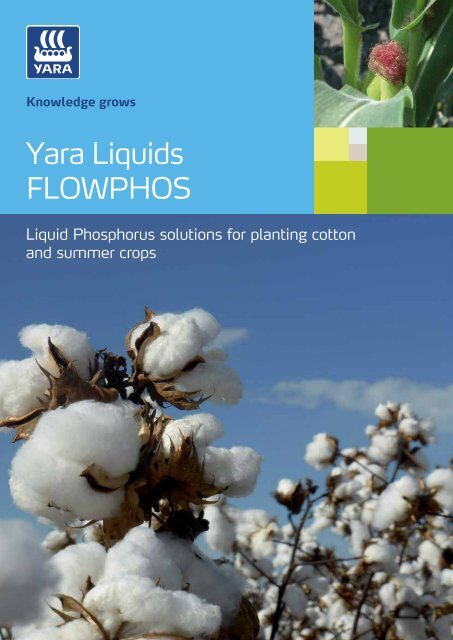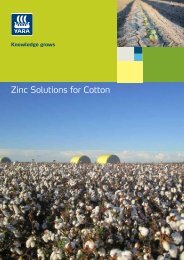Yara Liquids FLOWPHOS
2duE7oK
2duE7oK
You also want an ePaper? Increase the reach of your titles
YUMPU automatically turns print PDFs into web optimized ePapers that Google loves.
<strong>Yara</strong> <strong>Liquids</strong><br />
<strong>FLOWPHOS</strong><br />
Liquid Phosphorus solutions for planting cotton<br />
and summer crops
Phosphorus (P) is an essential nutrient for crop growth and<br />
development of cotton and summer crops. It is part of the<br />
universal energy carrier (Adenosine triphosphate or ATP) in<br />
plants and is involved with many plant metabolic processes,<br />
enzyme activity and the development of new cells in the<br />
shoots and roots. Although the requirement for phosphorus<br />
is lower than nitrogen and potassium, it is no less important<br />
to healthy plant growth and profitable crop production.<br />
Phosphorus, unlike nitrogen and sulphur, is immobile in the<br />
soil and therefore placement and timing of applications is<br />
very important.<br />
Phosphorus is taken up throughout the entire development<br />
of the crop (Figures 1 & 2). To ensure that phosphorus is<br />
not limiting yield potential, adequate soil P reserves are<br />
necessary to meet the crops demands for P.<br />
When soil P reserves are adequate, your phosphorus<br />
applications should at least replace the P removed by the<br />
crop (Table 1). For most summer crops this means a 2 fold<br />
application technique is needed. Some starter P placed<br />
with the seed (<strong>Yara</strong> <strong>Liquids</strong> <strong>FLOWPHOS</strong> is ideal for this<br />
application) and the majority of the P placed at 20 to 40 cm<br />
deep where the crops roots are most active. Starter P also<br />
helps overcome the lower availability of P in cold soils (Figure<br />
4 and photo opposite)<br />
This concept is supported by research led by Mike Bell<br />
(DAFF Qld) as it showed the best crop responses to applied<br />
phosphorus on low P sites were by applying 3 to 4kg/ha P as<br />
an in-furrow starter and the 20 to 40kg/ha P applied 20 to<br />
40cm deep for building P availability, as illustrated in figure<br />
3. Banding applications to replace crop removal of P works<br />
well for sorghum and corn but not as well for cotton. Deep<br />
application for cotton should be mixed through the soil if<br />
possible.<br />
Figure 1: Relative nutrient uptake by growth stage for<br />
corn<br />
Figure 2: Nutrient uptake for a 12 ba/ha cotton crop<br />
400<br />
Total nutrient uptake (%)<br />
120<br />
100<br />
80<br />
60<br />
40<br />
20<br />
0<br />
Reproductive stage<br />
Vegetative stage<br />
VE V1 V3 V5 V6 V7/9 V13 VT R1 R3 R4 R5 R6<br />
Growth stages<br />
Nutrient uptake (kg/ha)<br />
350<br />
300<br />
250<br />
200<br />
150<br />
100<br />
50<br />
0<br />
0 300 600 900 1200 1500 1800 2100<br />
Day Degrees<br />
N P K Mg<br />
N P K<br />
Source: Zscheischler et al. 1984<br />
Source: C Dowling
Table 1: Phosphorus uptake and removal for the 3 main<br />
summer crops.<br />
Sorghum kg/ton Corn kg/ton Cotton kg/ba<br />
Crop uptake 5 4.5 4.1<br />
Removal 3.7 3.3 2.3<br />
Figure 3: <strong>Yara</strong> <strong>Liquids</strong> <strong>FLOWPHOS</strong> applied in-furrow to<br />
help with crop establishment and NPK applied deeper in<br />
the soil, to supply seasonal crop requirements.<br />
Response to <strong>Yara</strong> <strong>Liquids</strong><br />
<strong>FLOWPHOS</strong> KZ at planting<br />
No starter Phosphorus<br />
used<br />
Planting in Central QLD<br />
(courtesey of Pioneer Seeds)<br />
Symptoms of P deficiency are;<br />
• Slow emergence and growth<br />
• Stunted and spindly plants<br />
• Off-green coloured foliage with purplish veins and<br />
purplish petioles due to anthocyanin accumulation<br />
In-furrow application of <strong>Yara</strong> <strong>Liquids</strong> <strong>FLOWPHOS</strong><br />
at planting<br />
Generally cotton and summer crops are planted as soon<br />
as soil temperatures reach the minimum threshold. Low<br />
soil temperatures slow down soil physical processes,<br />
chemical reactions, biological activity and reduce solubility of<br />
phosphorus compounds, which reduces the concentration of<br />
P in the soil solution, as can be seen in Figure 4.<br />
Figure 4: Influence of soil temperature on Phosphorus<br />
availability<br />
Relative availability P (%)<br />
100<br />
80<br />
60<br />
40<br />
20<br />
Rates of <strong>Yara</strong> <strong>Liquids</strong> <strong>FLOWPHOS</strong> that supply 3 to 4kg P/ha<br />
are an effective option to prevent early season P deficiency.<br />
<strong>Yara</strong> <strong>Liquids</strong> <strong>FLOWPHOS</strong> provides high<br />
concentration of available P to a relatively<br />
inefficient root system. This ensures high plant<br />
P concentration during important early growth<br />
stages;<br />
• Development of extensive root system<br />
• Floral initiation (establishment of grain number)<br />
• Important for establishing high yield potential<br />
<strong>Yara</strong> <strong>Liquids</strong> <strong>FLOWPHOS</strong> reduces the negative effects of<br />
many types of stress on plant growth and development<br />
through supplying 100% water soluble nutrients in an easily<br />
accessible band next to the seed<br />
Stresses which cause poor nutrient uptake soils are;<br />
• Cold, wet soils<br />
• Compacted soils<br />
• Soils with low P status<br />
0<br />
21 18 16 13<br />
Soil temperature (Cº)<br />
<strong>Yara</strong> <strong>Liquids</strong> <strong>FLOWPHOS</strong> can be tank mixed with many<br />
insecticides and to protect young seedlings.<br />
If phosphorus is not applied as a starter, small developing<br />
cotton and summer crops may suffer from P deficiency as<br />
shown in Figure 5.<br />
Figure 5: Phosphorus<br />
deficient corn<br />
A well setup planter applies <strong>Yara</strong> <strong>Liquids</strong> <strong>FLOWPHOS</strong> in a<br />
uniform stream as illustrated in figure 3. In most situations,<br />
but particularly in colder soils, plants benefit from phosphorus<br />
placed close to the seed, regardless of soil P levels.<br />
<strong>Yara</strong> <strong>Liquids</strong> <strong>FLOWPHOS</strong> Range for cotton and summer<br />
crop<br />
<strong>FLOWPHOS</strong> <strong>FLOWPHOS</strong> <strong>FLOWPHOS</strong><br />
15 13z kz<br />
Nitrogen (N) 10% 9% 7.5%<br />
Phosphorus<br />
(P)<br />
15% 13.5% 14.1%<br />
Potassium<br />
(K) 1.0% 6.5%<br />
Zinc (Zn):<br />
EDTA<br />
0.9% 0.5%
Irrigated Cotton Crop Program<br />
Pre-Plant Planting Emergence<br />
1st Squares<br />
1st Squares<br />
1st Flowers<br />
1st Flower<br />
Peak Flower<br />
Peak Flower<br />
Bolls Open<br />
Approximate<br />
Day Degrees<br />
<strong>Yara</strong> <strong>Liquids</strong><br />
Zn-SUL<br />
Apply<br />
20-60 L/ha and<br />
incorporate into<br />
soil<br />
70 - 540 540 - 840 840 -1300 1300 - 1600<br />
<strong>Yara</strong> <strong>Liquids</strong><br />
<strong>FLOWPHOS</strong> 13Z<br />
Apply<br />
100-200L/ha<br />
Apply<br />
30-40 L/ha<br />
in-furrow<br />
<strong>Yara</strong> <strong>Liquids</strong><br />
P-FOL Zinc<br />
Apply a band spray 3-5 L/ha<br />
<strong>Yara</strong>Vita <br />
ZINTRAC<br />
Apply 300mL-1 L/ha<br />
<strong>Yara</strong>Vita <br />
GLYTREL ZnP<br />
<strong>Yara</strong> <strong>Liquids</strong><br />
K-FLOW 0-14-30<br />
<strong>Yara</strong> <strong>Liquids</strong><br />
K-FLOW 4-0-12<br />
<strong>Yara</strong> <strong>Liquids</strong><br />
N26<br />
<strong>Yara</strong> <strong>Liquids</strong><br />
N-FOL 24+TE<br />
Apply<br />
400-500L/ha<br />
in pre-irrigation<br />
Apply 2-3 L/ha as required with<br />
Glyphosate<br />
Apply 1-2 applications of 10 L/ha<br />
Apply 2-3 applications of<br />
30 L/ha, starting 7-10 days after<br />
first flower<br />
Apply 500-600 L/ha in multiple applications<br />
Apply 30-40 L/ha as required<br />
While <strong>Yara</strong> Australia has taken all reasonable care in the preparation of this document, the information is a guide only. It is advised that potential users read the products Safety Data<br />
Sheet prior to using the product, which is available on request from <strong>Yara</strong> Australia. There are no warranties, express or implied by operation of law or otherwise, including but not limited to<br />
any warranty as to merchantability or fitness for any particular purpose.<br />
www<br />
1800 684 266 <strong>Yara</strong>_Australia au.sales@yara.com<br />
www.yara.com.au



